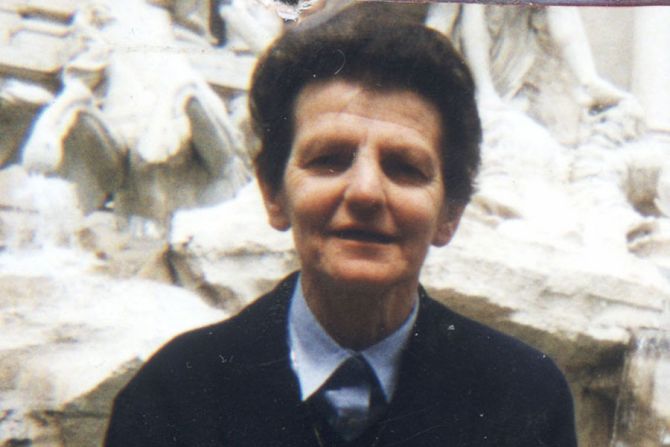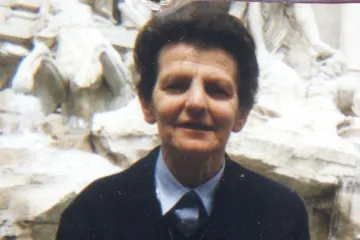Rome Newsroom, Oct 22, 2020 / 04:00 am
The three teenage girls who killed Sr. Maria Laura Mainetti 20 years ago attested afterward that, while they were stabbing the 60-year-old religious sister to death, she told them she forgave them.
"The sister cried out. She said she would not report us. That she forgave us," Milena De Giambattista, Ambra Gianasso, and Veronica Pietrobelli told police when they confessed to killing the woman as part of a Satanic ritual.
In May, Pope Francis declared Venerable Maria Laura Mainetti a martyr, killed in "hatred of the faith" in Chiavenna, Italy. She will be beatified on June 6, 2021, the 21st anniversary of her murder.
Born in a small town in northern Italy, Mainetti entered the Congregation of the Sisters of the Cross at age 18. In 1984 she moved to the convent in Chiavenna, where she became superior.
Mainetti was known in the small town for her social and charitable commitment to dispossessed youth and poor people. According to a person who knew her, Mainetti had "an unconditional love for the weak. A life that was a real witness of love for Christ."
"She never said no to anyone: she always opened the door ready to listen," the person added.
The sister displayed this quality on the seemingly ordinary Tuesday night when the teens drew her out of the convent with a call claiming that a girl was pregnant by rape and needed to speak with her. They brought the sister to an isolated and dark street, near a cliff called "Paradise," which originated from an ancient soapstone quarry.
According to local legend, a 160-feet tall and nearly 500-foot deep opening in the side of the cliff leads to the "inferno," and was the work of the devil, who created the fissure to escape to hell while fleeing the Virgin Mary.
The three teens, dressed in black, then stabbed Mainetti 19 times with a kitchen knife and beat her, while shouting abuse. They had, according to Italian media reports, intended to stab her 18 times, six times each, to form by their violence the number 666.
"I deceived her by drawing her into a trap and then I killed her, and while we were doing this she forgave us," Milena De Giambattista wrote to Sr. Mainetti's religious community some years after the act.
"I can have of her only a memory of love. And in addition to this, it also allowed me to believe in something that is neither God nor Satan, but which was a simple woman who defeated evil," Milena wrote.
"Now in her I find comfort and the grace to endure everything. I always pray and I am sure she will help me become a better person."
Milena's letter is included in an Italian-language biography of Mainetti written by Sr. Beniamina Mariani in 2005.
Sr. Mainetti was known to the girls, who did not have any prior history of violence or crime. They confessed that they had originally planned to kill the parish priest, but decided that, because he was larger, it would prove too difficult. Investigators said that the girls' notebooks were filled with Satanic writings and they had made a blood oath some months earlier.
The three served sentences in different juvenile prisons. After their release, between six and seven years later, at least two of them spent time in community recovery centers. According to media reports, the women changed their names, and now have jobs and families.
After her release from prison in 2006, Milena was a guest for several years of the Exodus communities in the area of Verona -- residences for the prevention and treatment of drug addiction, founded by Fr. Antonio Mazzi.
(Story continues below)
Mazzi once said, as recounted by Amedeo Mainetti, the murdered nun's brother, that Milena "is fully aware of what she did and at the same time repentant and convinced that she can be reborn and recover better and better."
Speaking to Il Giorno Milano newspaper in June this year, Mazzi said that Milena had been an active participant in the communities, though she never spoke about the murder and they never "fully faced the fact" with her.
The priest also noted that Milena "never declared herself a believer and neither the opposite."
"She did not want to give testimony for the sister. However, she radically changed her life, and with her actions she clearly showed that she was repentant and that she understood that she had made a great mistake," he said. "Today she has her own life and her own job."
In a 2008 interview in the magazine Panorama, Veronica asked the public to forget her.
"Prison, psychologists, and the recovery community have allowed me to become the person I otherwise would never have been," she said.
"It was decided to kill at age 16 while sitting for six hours over a beer in a small village bar," she recalled. "Everything we said, thought and did was worthless. What was I terrified of? Of Sr. Maria Laura's gaze? Of blood? I don't know, because it was dark and I didn't look at her face, just as I didn't look at the blood. At that moment and only then, I was afraid of everything, even of Ambra and Milena."
In her biography of the slain religious sister, Mariani wrote that when she was among young people, Mainetti felt "at ease and loved to entertain them both in scheduled meetings and in casual ones."
Someone who knew her said in an interview for the book that "only God can know how much she sacrificed herself for young people! Meetings, talks, school camps, world youth days, catechesis, individual accompaniment."
The biography reproduced what Mainetti wrote in her journal on the day of her perpetual profession in 1964: "Give me your feelings, Jesus, those of the Beatitudes: the poor who trusts, abandons himself/the child who feels loved by him/the affliction that is participation in that of Christ and is salvation/Mercy, Benevolence, Purity of body and heart, Humility. To serve Christ is to reign: Here I am… The joy of my service every instant in conformity with Your Divine Will."
From this life, "a spring gushes out, a gush of evangelical life," Sr. Kitty Hiriat Urruty, the superior of her congregation, wrote at the time of Mainetti's martyrdom.
"This spring speaks to us of our consecration, of our life offered to the Trinity, of our desire of identification with Jesus Christ, of our choice of the poorest, of the wounded in life. And this leads to the origins of our Congregation," the sister said.
"She showed that our charism is alive and very current," she continued. "In this style of love and gift, she gave herself with both hands, without calculation, just like someone who knows that all she has is a gift of love, to be shared and made to bear fruit."




